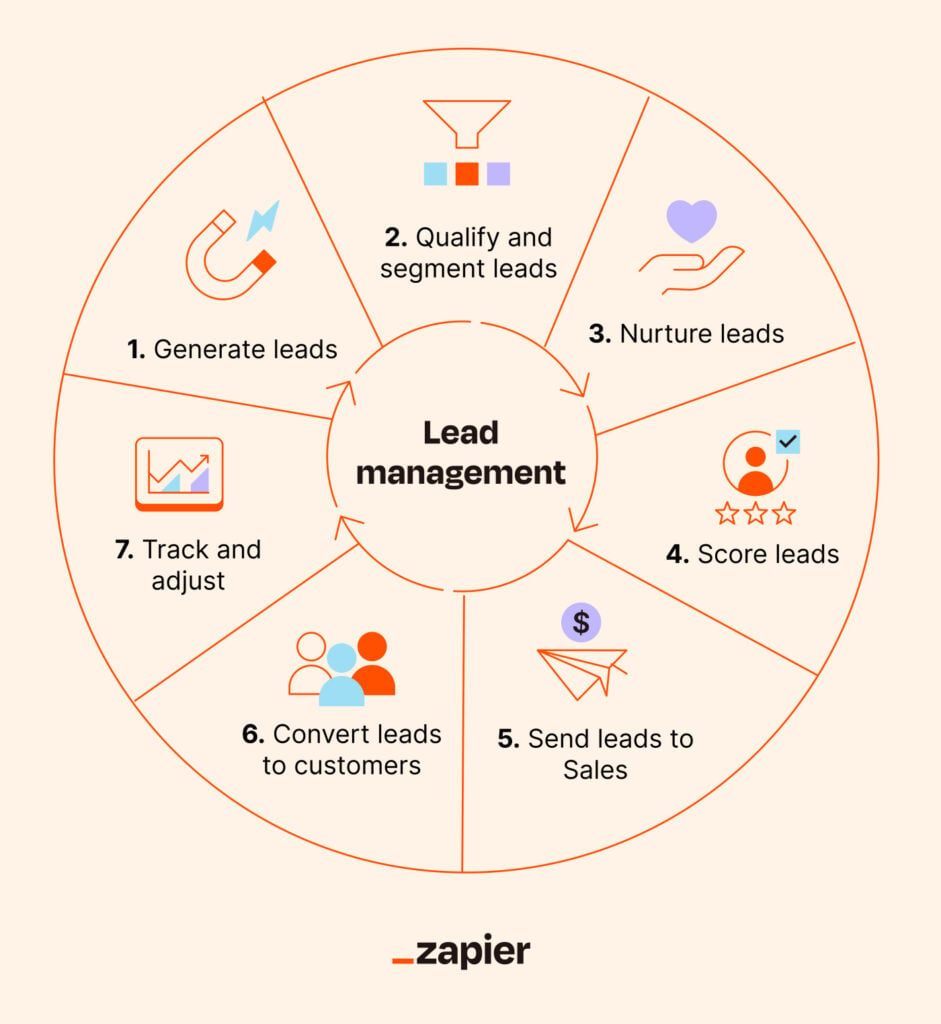A 6-Step Guide to Optimize Your Funnel
Lead management means actively managing and shaping the buyer’s journey until they're ready to become customers.
An effective strategy lets you differentiate the window shoppers from the sales-ready customers. When paired with marketing automation, Invesp found that 80% of businesses saw increased lead generation and conversion.
Follow these six steps to get your lead management process off the ground and start building your sales pipeline.
What is Lead Management?
Lead management is identifying and generating potential customers, tracking their activities and behavior, nurturing them to be sales-ready, passing them over to the sales team, and monitoring the entire process to optimize it.
AKA guiding leads through the lead funnel from awareness to conversion.

The flow of the lead management process typically looks like this:
- Identification: Forms and analytic tools integrated within your website and other channels collect lead information.
- Tracking: Your CRM software or lead management tool monitors how they behave on your website. Such as pages they visit, click-through rates, and other engagement metrics.
- Qualification: Using lead scoring, you'll rank and compare which potential buyers are more likely to become customers. These are your qualified leads, and they are ready for the sales process.
- Nurturing: Here, marketing teams prep leads who aren't sales-ready rather than letting them go. They'll use email campaigns and other tactics to engage with them and address pain points.
- Conversion: The marketing team hands over the right leads to the salespeople, where they'll receive personalized treatments and follow-ups.
6 Steps for an Effective Lead Management Process
1. Start with Lead Generation
As with almost everything in business, lead generation should start with understanding your audience and finding the means to capture them. The most popular channels for lead generation include SEO, digital advertising, content marketing, and social media.
SEO
Users click on organic listings appearing on the search engine results pages (SERPs) 73% of the time, indicating that it's a major trust-building tool.
SEO's main goal is to boost organic traffic to the site by optimizing its elements to align with search engine algorithms, for example, adding keywords to the title and image alt texts.
Digital Advertising
Advertising on YouTube, Google, Facebook, and other platforms also helps to catch the attention of users who may follow links or recommendations. For example, you can create a video showcasing your product's best qualities and promote it on Facebook.
Content Marketing & Social Media
You can also generate leads by collecting contact information from social media users by inviting them to sign up for a blog, newsletter, or promotion. You may also offer potential customers information through ebooks, webinars, case studies, or training videos.
2. Implement Lead Scoring
After acquiring leads, you need to segment these leads based on the level of interest in your brand. That’s where lead scoring comes in.
Lead scoring tools help segment your leads by firmographic data, like demographics, organization, industry, number of employees, engagement with your company, and other behavior metrics.
The scores clearly distinguish your hot (best leads), warm (leads on the fence), and cold (disengaged leads) prospects, helping Sales and Marketing teams allocate their time and efforts more efficiently.
Most importantly, your lead scoring model should be based on iteration. Don't just set it and leave it alone.
Enable teams on using technologies in their workflows, such as CRM systems, marketing automation tools, and analytics platforms to continually reduce speed to lead and shorten sales cycles.
3. Move on to Lead Nurturing
Lead nurturing refers to engaging warm or cold leads with valuable content at each stage of the sales funnel — from initial awareness to the final decision-making phase.
Here are some strategies you can use to master nurture campaigns:
- Use targeted outreach: Collect and centralize your customer data with CRM apps or cold calling software. Then, use the insights to identify your target customers and design a personalized email marketing strategy. Emails should refer to the customers directly using their names, company names, or pain points. Personalized emails have an open rate of 36%.
- Use content marketing: Write articles, blog posts, and white papers, or use videos to drive organic traffic to your website. 43% of marketers say videos perform best, followed by short-form articles. 45% say researching and adding related keywords in addition to the primary ones is their number one tactic for ranking highly.
- Use lead magnets: Content marketing attracts and educates, while lead magnets offer gated value in exchange for customer information. E.g., ebooks and whitepapers such as industry reports, templates, etc. Leads must fill out a form with their information to access this content. 26% of markets say written lead magnets have higher conversion rates than others.
4. Send Qualified Leads to the Sales Team
Lead distribution or routing means handing the most valuable leads to your sales team at the right time to close the deal.
Automating lead routing reduces the time it takes to get leads to your sales team and equips you to use data-driven insights to identify which lead is assigned to which person.
Lead Assign, HubSpot, and Freshsales are among the top lead routing software. But before you pick one, check its integration support. You want a tool that facilitates the smooth flow of data between existing and new platforms.
Before setting up your lead distribution system, you should know:
- When your sales reps are available to assist potential customers.
- How experienced your representatives are with specific problems, products, and services.
- A team member’s success rate handling similar clients.
- Whether your sales representative needs to be located in the same geographic location as your client.
5. Track and Measure
Tracking and measuring leads is the only way to evaluate your success rate. You can use lead tracking, data analysis, and machine learning technology to identify common obstacles and potential solutions. Setting KPIs for lead generation will help find the most effective channels.
You can track leads via software or manually in a prospecting spreadsheet.
Key metrics to track
- Lead source: The channels that bring leads in — organic search, social media, targeted ads, referral, etc.
- Conversion rates: Percentage of leads that pass through the sales funnel and become customers.
- Acquisition cost: Calculate the cost of acquiring each lead.
- Retention rate: Calculate the percentage of leads or customers that stay with your business for a specific period.
- Churn rate: Measure the rate at which leads disengage with your channels.
- Average transaction value: The potential financial impact of converting a lead to a customer.
6. Follow Up
Following up with your old leads allows you to create new potential opportunities. One of the best ways to do this is to segment and score these leads to use the right follow-up strategy for each lead type — like an extended nurture campaign.
Benefits of Lead Management
Today’s teams are leaner than ever, which means efficiency is the key to productivity. A well-defined lead management process lends itself to:
Efficiency in Resource Allocation
Lead management allows you to invest your resources more efficiently. It helps you decide which parts of the process to automate so you focus your time, tools, manpower, and other resources on the leads most likely to convert.
Adaptation to Market Disruptions
Effective lead management systems provide valuable insights into customer behavior, feeding data into your customer acquisition strategy and allowing you to make more informed decisions in response to changes in your industry or the economy at large.
More Articles
Revenue Increase
Companies with effective lead-generation practices have surpassed their competition with a 133% increase in revenue.
When you can consistently attract and convert hot leads, you have a better shot at increasing your market share and tapping into a steady stream of paying customers. Conversely, you’re also cutting costs by not pursuing immature leads.
Measure Business Effectiveness
With lead qualification tools, you can track how many new and old leads interact with your business and the lead generation sources (where they discovered you). Then, you can measure their conversion rate. A higher rate suggests that your strategies are resonating with your target audience.
With this knowledge, you can tweak your lead management process to boost your closing rates, return on investment, and engagement with new and existing customers—organizations who use lead scoring witness a 77% increase in ROI.
Lead the Way
Lead management is a multi-step process that touches every part of the customer journey. Without a strategic lead management process, your go-to-market teams will be inefficient, less productive, and could ultimately cost your business.
Want to take your RevOps game to the next level? The RevOps Team is launching a newsletter soon. Sign up to get career resources, software reviews, and advice from RevOps experts delivered to your inbox.


